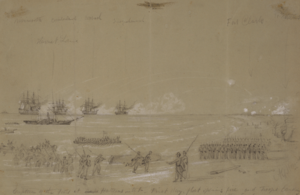Battle of Hatteras Inlet Batteries
| Battle of Hatteras Inlet Batteries | |||||||
|---|---|---|---|---|---|---|---|
| Part of the American Civil War | |||||||
 Capture of the Forts at Cape Hatteras inlet Alfred R. Waud, artist, August 28, 1861. |
|||||||
|
|||||||
| Belligerents | |||||||
|
|
|
||||||
| Commanders and leaders | |||||||
|
Silas H. Stringham Benjamin F. Butler |
Samuel Barron William F. Martin |
||||||
| Units involved | |||||||
|
9th New York Infantry 20th New York Infantry Atlantic Blockading Squadron |
17th North Carolina Infantry Regiment Hatteras Island Garrison Unspecified naval volunteers |
||||||
| Strength | |||||||
| 7 warships 935 men |
900 men | ||||||
| Casualties and losses | |||||||
| 1 killed 2 wounded |
4 killed 20 wounded 691 captured |
||||||
The Battle of Hatteras Inlet Batteries (August 28-29, 1861) was the first combined operation of the Union Army and Navy in the American Civil War, resulting in Union domination of the strategically important North Carolina Sounds.
Two forts on the Outer Banks (Fort Clark and Fort Hatteras) had been built by the Confederates, to protect their commerce-raiding activity. But these were lightly-defended, and their artillery could not engage the bombarding fleet under Flag Officer Silas H. Stringham, commandant of the Atlantic Blockading Squadron, which had been ordered to keep moving, to avoid presenting a static target. Although held up by bad weather, the fleet was able to land troops under General Ben Butler, who took the surrender of Flag Officer Samuel Barron.
This battle represented the first application of the naval blockading strategy. The Union retained both forts, providing valuable access to the sounds, and commerce raiding was much reduced. The victory was welcomed by a demoralised Northern public after the humiliation of 1st Bull Run. The engagement is sometimes known as the Battle of Forts Hatteras and Clark.
The North Carolina Sounds occupy most of the coast from Cape Lookout (North Carolina) to the Virginia border. With their eastern borders marked by the Outer Banks, they were almost ideally located for raiding Northern maritime commerce. Cape Hatteras, the easternmost point in the Confederacy, is within sight of the Gulf Stream, which moves at a speed of about 3 knots (1.5 m/s) at this latitude. Ships in the Caribbean trade would reduce the time of their homeward journeys to New York, Philadelphia, or Boston by riding the stream to the north. Raiders, either privateers or state-owned vessels, could lie inside, protected from both the weather and from Yankee blockaders, until an undefended victim appeared. Watchers stationed at the Hatteras lighthouse would then signal a raider, which would dash out and make a capture, often being able to return the same day.
To protect the raiders from Federal reprisal, the state of North Carolina immediately after seceding from the Union established forts at the inlets, waterways that allowed entrance to and egress from the sounds. In 1861, only four inlets were deep enough for ocean-going vessels to pass: Beaufort, Ocracoke, Hatteras, and Oregon Inlets. Hatteras Inlet was the most important of these, so it was given two forts, named Fort Hatteras and Fort Clark Fort Hatteras was sited adjacent to the inlet, on the sound side of Hatteras Island. Fort Clark was about half a mile (800 m) to the southeast, closer to the Atlantic Ocean. The forts were not very strong; Fort Hatteras had only ten guns mounted by the end of August, with another five guns in the fort but not mounted. Fort Clark had only five. Furthermore, most of the guns were rather light 32-pounders or smaller, of limited range and inadequate for coastal defense.
...
Wikipedia
